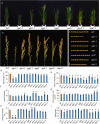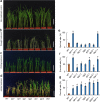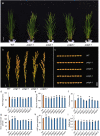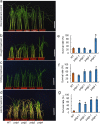Heterotrimeric G protein are involved in the regulation of multiple agronomic traits and stress tolerance in rice
- PMID: 32111163
- PMCID: PMC7048073
- DOI: 10.1186/s12870-020-2289-6
Heterotrimeric G protein are involved in the regulation of multiple agronomic traits and stress tolerance in rice
Abstract
Background: The heterotrimeric G protein complex, consisting of Gα, Gβ, and Gγ subunits, are conserved signal transduction mechanism in eukaryotes. Recent molecular researches had demonstrated that G protein signaling participates in the regulation of yield related traits. However, the effects of G protein genes on yield components and stress tolerance are not well characterized.
Results: In this study, we generated heterotrimeric G protein mutants in rice using CRISPR/Cas9 (Clustered Regularly Interspaced Short Palindromic Repeats) gene-editing technology. The effects of heterotrimeric G proteins on the regulation of yield components and stress tolerance were investigated. The mutants of gs3 and dep1 generated preferable agronomic traits compared to the wild-type, whereas the mutants of rga1 showed an extreme dwarf phenotype, which led to a dramatic decrease in grain production. The mutants showed improved stress tolerance, especially under salinity treatment. We found four putative extra-large G proteins (PXLG)1-4 that also participate in the regulation of yield components and stress tolerance. A yeast two hybrid showed that the RGB1 might interact with PXLG2 but not with PXLG1, PXLG3 or PXLG4.
Conclusion: These findings will not only improve our understanding of the repertoire of heterotrimeric G proteins in rice but also contribute to the application of heterotrimeric G proteins in rice breeding.
Keywords: CRISPR/Cas9; Heterotrimeric G protein; Rice; Stress tolerance; Yield components.
Conflict of interest statement
The authors declare that they have no competing interests.
Figures







Similar articles
-
Extra-large G proteins have extra-large effects on agronomic traits and stress tolerance in maize and rice.Trends Plant Sci. 2023 Sep;28(9):1033-1044. doi: 10.1016/j.tplants.2023.04.005. Epub 2023 May 7. Trends Plant Sci. 2023. PMID: 37156701 Free PMC article. Review.
-
Rice heterotrimeric G-protein gamma subunits (RGG1 and RGG2) are differentially regulated under abiotic stress.Plant Signal Behav. 2012 Jul;7(7):733-40. doi: 10.4161/psb.20356. Epub 2012 Jul 1. Plant Signal Behav. 2012. PMID: 22751322 Free PMC article.
-
Heterotrimeric G proteins regulate nitrogen-use efficiency in rice.Nat Genet. 2014 Jun;46(6):652-6. doi: 10.1038/ng.2958. Epub 2014 Apr 28. Nat Genet. 2014. PMID: 24777451
-
Emerging insights into heterotrimeric G protein signaling in plants.J Genet Genomics. 2016 Aug 20;43(8):495-502. doi: 10.1016/j.jgg.2016.06.004. Epub 2016 Jul 6. J Genet Genomics. 2016. PMID: 27520410 Review.
-
Mutation of RGG2, which encodes a type B heterotrimeric G protein γ subunit, increases grain size and yield production in rice.Plant Biotechnol J. 2019 Mar;17(3):650-664. doi: 10.1111/pbi.13005. Epub 2018 Dec 13. Plant Biotechnol J. 2019. PMID: 30160362 Free PMC article.
Cited by
-
An atypical heterotrimeric Gα and its interactome suggest an extra-large role in overcoming abiotic and biotic stress.Physiol Mol Biol Plants. 2023 Oct;29(10):1543-1561. doi: 10.1007/s12298-023-01378-6. Epub 2023 Nov 1. Physiol Mol Biol Plants. 2023. PMID: 38076761 Free PMC article. Review.
-
Fine Mapping of Five Grain Size QTLs Which Affect Grain Yield and Quality in Rice.Int J Mol Sci. 2024 Apr 9;25(8):4149. doi: 10.3390/ijms25084149. Int J Mol Sci. 2024. PMID: 38673733 Free PMC article.
-
Gene Pyramiding Strategies for Sink Size and Source Capacity for High-Yield Japonica Rice Breeding.Rice (N Y). 2025 Feb 13;18(1):6. doi: 10.1186/s12284-025-00756-w. Rice (N Y). 2025. PMID: 39945924 Free PMC article. Review.
-
CRISPR/Cas: a Nobel Prize award-winning precise genome editing technology for gene therapy and crop improvement.J Zhejiang Univ Sci B. 2021 Apr 15;22(4):253-284. doi: 10.1631/jzus.B2100009. J Zhejiang Univ Sci B. 2021. PMID: 33835761 Free PMC article. Review.
-
Rapid Visual Detection of Elite Erect Panicle Dense and Erect Panicle 1 Allele for Marker-Assisted Improvement in Rice (Oryza sativa L.) Using the Loop-Mediated Isothermal Amplification Method.Curr Issues Mol Biol. 2024 Jan 4;46(1):498-512. doi: 10.3390/cimb46010032. Curr Issues Mol Biol. 2024. PMID: 38248334 Free PMC article.
References
MeSH terms
Substances
Grants and funding
LinkOut - more resources
Full Text Sources
Other Literature Sources

